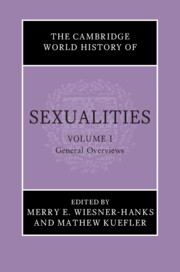104 results
18 - Sex in Lagos from the Mid-Nineteenth to the Mid-Twentieth Century
-
-
- Book:
- The Cambridge World History of Sexualities
- Published online:
- 26 April 2024
- Print publication:
- 16 May 2024, pp 379-401
-
- Chapter
- Export citation
16 - Sex Trafficking in the Modern World
-
-
- Book:
- The Cambridge World History of Sexualities
- Published online:
- 26 April 2024
- Print publication:
- 16 May 2024, pp 342-357
-
- Chapter
- Export citation
3 - Sexuality in the Systems of Thought and Belief of the Ancient Near East
-
-
- Book:
- The Cambridge World History of Sexualities
- Published online:
- 26 April 2024
- Print publication:
- 16 May 2024, pp 43-62
-
- Chapter
- Export citation
10 - The Impact of the World Wars on Modern Sexuality
-
-
- Book:
- The Cambridge World History of Sexualities
- Published online:
- 26 April 2024
- Print publication:
- 16 May 2024, pp 204-226
-
- Chapter
- Export citation
25 - Sex in Twentieth-Century Rio de Janeiro
-
-
- Book:
- The Cambridge World History of Sexualities
- Published online:
- 26 April 2024
- Print publication:
- 16 May 2024, pp 532-552
-
- Chapter
- Export citation
17 - Sexual Science in History
-
-
- Book:
- The Cambridge World History of Sexualities
- Published online:
- 26 April 2024
- Print publication:
- 16 May 2024, pp 362-387
-
- Chapter
- Export citation
21 - Sex in Early Twentieth-Century Berlin
-
-
- Book:
- The Cambridge World History of Sexualities
- Published online:
- 26 April 2024
- Print publication:
- 16 May 2024, pp 440-464
-
- Chapter
- Export citation
9 - Sexuality in Tenochtitlan in the Early Sixteenth Century
-
-
- Book:
- The Cambridge World History of Sexualities
- Published online:
- 26 April 2024
- Print publication:
- 16 May 2024, pp 172-190
-
- Chapter
- Export citation
17 - Sex in Manila in the Late Nineteenth and Early Twentieth Centuries
-
-
- Book:
- The Cambridge World History of Sexualities
- Published online:
- 26 April 2024
- Print publication:
- 16 May 2024, pp 353-378
-
- Chapter
- Export citation
13 - Sex in Eighteenth-Century Paris
-
-
- Book:
- The Cambridge World History of Sexualities
- Published online:
- 26 April 2024
- Print publication:
- 16 May 2024, pp 261-284
-
- Chapter
- Export citation
1 - Sex in Athens in the Fifth and Fourth Centuries bce
-
-
- Book:
- The Cambridge World History of Sexualities
- Published online:
- 26 April 2024
- Print publication:
- 16 May 2024, pp 1-26
-
- Chapter
- Export citation
15 - The Sale of Sex in History
-
-
- Book:
- The Cambridge World History of Sexualities
- Published online:
- 26 April 2024
- Print publication:
- 16 May 2024, pp 315-338
-
- Chapter
- Export citation
8 - Sex in Florence in the Fifteenth Century
-
-
- Book:
- The Cambridge World History of Sexualities
- Published online:
- 26 April 2024
- Print publication:
- 16 May 2024, pp 150-171
-
- Chapter
- Export citation
12 - Sex in Eighteenth-Century Edo (Tokyo)
-
-
- Book:
- The Cambridge World History of Sexualities
- Published online:
- 26 April 2024
- Print publication:
- 16 May 2024, pp 232-260
-
- Chapter
- Export citation
16 - Sexual Pleasures and Perils in Nineteenth-Century London
-
-
- Book:
- The Cambridge World History of Sexualities
- Published online:
- 26 April 2024
- Print publication:
- 16 May 2024, pp 329-352
-
- Chapter
- Export citation
Chapter 2 - Just Like Any Other Worker? Class, Gender, and Labor Rights
- from Part I Introduction
-
- Book:
- Domestic Service in the Soviet Union
- Published online:
- 25 April 2024
- Print publication:
- 02 May 2024, pp 64-91
-
- Chapter
- Export citation

The Cambridge World History of Sexualities
-
- Published online:
- 26 April 2024
- Print publication:
- 16 May 2024
5 - Rejecting Honest Work
-
- Book:
- Selling French Sex
- Published online:
- 04 January 2024
- Print publication:
- 25 January 2024, pp 157-197
-
- Chapter
- Export citation
4 - The Gender of Identity Documents
-
- Book:
- Selling French Sex
- Published online:
- 04 January 2024
- Print publication:
- 25 January 2024, pp 122-156
-
- Chapter
- Export citation
6 - Reputation and Repatriation
-
- Book:
- Selling French Sex
- Published online:
- 04 January 2024
- Print publication:
- 25 January 2024, pp 198-232
-
- Chapter
- Export citation

